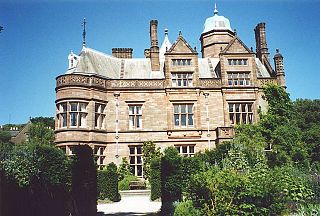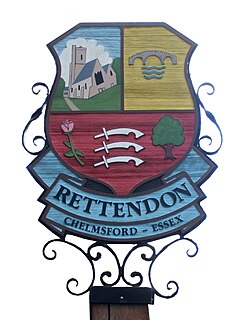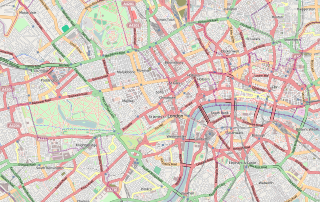
Hyde Park is a Grade I-listed major park in Central London. It is the largest of four Royal Parks that form a chain from the entrance of Kensington Palace through Kensington Gardens and Hyde Park, via Hyde Park Corner and Green Park past the main entrance to Buckingham Palace. The park is divided by the Serpentine and the Long Water lakes.

Kensington Gardens, once the private gardens of Kensington Palace, are among the Royal Parks of London. The gardens are shared by the City of Westminster and the Royal Borough of Kensington and Chelsea and sit immediately to the west of Hyde Park, in western central London. The gardens cover an area of 270 acres. The open spaces of Kensington Gardens, Hyde Park, Green Park, and St. James's Park together form an almost continuous "green lung" in the heart of London. Kensington Gardens are Grade I listed on the Register of Historic Parks and Gardens.

Holker Hall is a privately owned country house located about 2 km to the southwest of the village of Cartmel, Cumbria, England, a location previously in the historic county of Lancashire. It is "the grandest [building] of its date in Lancashire ...by the best architects then living in the county." The building dates from the 16th century, with alterations, additions, and rebuilding in the 18th and 19th centuries. The 19th century rebuilding was by George Webster in Jacobean Revival style and subsequent renovations were by E. G. Paley. Hubert Austin had a joint practice with Paley by the 1870s and they both rebuilt the west wing after it was destroyed by a major fire in 1871, only a decade after Paley's previous work on the structure. The fire also destroyed a number of notable artworks. Holker Hall is Paley and Austin's "most important country house commission." The architectural historian Nikolaus Pevsner expressed the opinion that the west wing is the "outstanding domestic work" of Paley and Austin. In 1970 the hall itself, together with its terrace wall, were designated Grade II* Listed buildings. The house stands in an estate of about 80 hectares, and is surrounded by formal gardens, parkland and woodland. Within the grounds are six structures listed at Grade II.

York House is a historic stately home in Twickenham, England, and currently serves as the Town Hall of the London Borough of Richmond upon Thames. It is situated in Richmond Road, near the centre of Twickenham, close to St Mary's Church.

Rettendon is a small village and civil parish in the Borough of Chelmsford in Essex, England about 8 miles (13 km) south east of the city of Chelmsford. Situated near the River Crouch the village was once owned by the Bishop of Ely. The A130 formerly passed through the village. There are a number of listed buildings in the parish.

Royal Garden Hotel is a 5 red star hotel in London, England. It is located in the heart of Kensington, on Kensington High Street, overlooking Kensington Palace and gardens. The palace, Hyde Park and the Royal Albert Hall can all be seen from the hotel.
Hyde Park Greyhound Stadium was a greyhound racing stadium on Manor Oaks Road in Sheffield, South Yorkshire, England.
Kirkby Ireleth is a civil parish in the South Lakeland District of Cumbria, England. It contains six listed buildings that are recorded in the National Heritage List for England. Of these, one is listed at Grade I, the highest of the three grades, two are at Grade II*, the middle grade, and the others are at Grade II, the lowest grade. The parish contains the village of Kirkby-in-Furness and smaller settlements including Beck Side and Grizebeck, but is almost completely rural. The former Furness Railway runs through the parish and a footbridge crossing the line at Kirkby-in-Furness railway station is listed. The other listed buildings are a former manor house now a farmhouse, a country house and its garden wall, a church, and a barn.
Bolton is a town in the Metropolitan Borough of Bolton, Greater Manchester, England, and its central area is unparished. The central area of the town contains over 230 listed buildings that are recorded in the National Heritage List for England. Of these, three are listed at Grade I, the highest of the three grades, 13 are at Grade II*, the middle grade, and the others are at Grade II, the lowest grade.
Tottington is a town in the Metropolitan Borough of Bury, Greater Manchester, England, and the area also includes the villages of Walshaw and Greenmount and the surrounding countryside. The area is unparished, and contains 33 listed buildings that are recorded in the National Heritage List for England. Of these, two are listed at Grade II*, the middle grade, and the others are at Grade II, the lowest grade. The area is partly agricultural and partly residential, and its listed buildings include farmhouses and farm buildings, private houses and associated structures, an ancient cross, churches and associated structures, a village lock-up, and schools.
Chadderton is a town in the Metropolitan Borough of Oldham, Greater Manchester, England and it is unparished. It contains 19 listed buildings that are recorded in the National Heritage List for England. Of these, one is listed at Grade II*, the middle grade, and the others are at Grade II, the lowest grade. The area was rural until the coming of the Industrial Revolution, silk weaving arrived in the 18th century, and in the 19th and 20th centuries large cotton mills were built. The Rochdale Canal runs through the town, and two structures associated with it are listed, a bridge and a lock. The oldest listed buildings are farmhouses and a country house. The later buildings reflect the growing wealth of the town, and include cotton mills, churches, civic buildings, and a war memorial.
Middleton is a town in the Metropolitan Borough of Rochdale, Greater Manchester, England, and it is unparished. The town and the surrounding countryside contain 43 listed buildings that are recorded in the National Heritage List for England. Of these, one is listed at Grade I, the highest of the three grades, seven are at Grade II*, the middle grade, and the others are at Grade II, the lowest grade. Until the coming of the Industrial Revolution Middleton was a village, then came the industries of silk, cotton and coal. The oldest listed buildings consist of a church and vicarage, country houses, a school, a public house, and a bridge. The Rochdale Canal passes through the area, and locks and a bridge on it are listed. The later listed buildings include more churches, houses and schools, a drinking fountain, a bank, a club, a cotton mill, a park feature, and war memorials. The architect Edgar Wood lived in the town and he, sometimes with his partner Henry Sellars, designed some of the later listed buildings.
Worsley is a town in the City of Salford Metropolitan Borough, Greater Manchester, England. The town, together with the areas of Walkden and Little Hulton, contains 56 listed buildings that are recorded in the National Heritage List for England. Of these, two are listed at Grade I, the highest of the three grades, and the others are at Grade II, the lowest grade.
Ashton-under-Lyne is a town in the Tameside, Greater Manchester, England. The town and the countryside to the north contain 51 listed buildings that are recorded in the National Heritage List for England. Of these, one is listed at Grade I, the highest of the three grades, seven are at Grade II*, the middle grade, and the others are at Grade II, the lowest grade.
Hyde is a town in Tameside, Greater Manchester, England. The town and the nearby area contains 37 listed buildings that are recorded in the National Heritage List for England. Of these, one is listed at Grade II*, the middle grade, and the others are at Grade II, the lowest grade. The listed buildings include houses, farmhouses, farm buildings, churches and associated structures, a public house, a former hatter's workshop, bridges crossing the Peak Forest Canal, a boundary stone, a canal warehouse, a railway viaduct, civic buildings, a former theatre, and war memorials.
Stretford is a town in the Metropolitan Borough of Trafford, Greater Manchester, England. The town contains 20 listed buildings that are recorded in the National Heritage List for England. All the listed buildings are designated at Grade II, the lowest of the three grades, which is applied to "buildings of national importance and special interest". The town is adjacent to the centre of Manchester, and is partly residential and partly industrial. The Bridgewater Canal and the Manchester Ship Canal run through the town, and there are listed buildings associated with both canals. The other listed buildings include two medieval structures, churches, the entrances to a former botanical garden and to a park, a factory, civic buildings, a former cinema, a hotel, and three war memorials.
Sharston Hall was a manor house built in Sharston, an area of Wythenshawe, Manchester, England, in 1701. A three-storey building with Victorian additions, it was purchased by Thomas Worthington, an early umbrella tycoon, and occupied by the Worthington family until 1856, when the last male heir died. The hall was occupied by the Henriques family in the 1920s, but following their death in a motor accident in 1932 the house was converted into flats. Manchester Corporation purchased the hall in 1926. During the Second World War it was leased by the local watch committee for use by the police, civil defence and fire services.
Manchester is a city in Northwest England. The M2 postcode area of the city includes part of the city centre, including the Central Retail District. The postcode area contains 143 listed buildings that are recorded in the National Heritage List for England. Of these, five are listed at Grade I, the highest of the three grades, 16 are at Grade II*, the middle grade, and the others are at Grade II, the lowest grade.
The Poets' Fountain was a public fountain with sculptures that was installed on a traffic island in Park Lane, London in 1875. It was removed in 1948 and it is thought to have been destroyed. One sculpture, an allegorical figure of Fame, is known to have survived and is displayed in the gardens at Renishaw Hall in Derbyshire.






